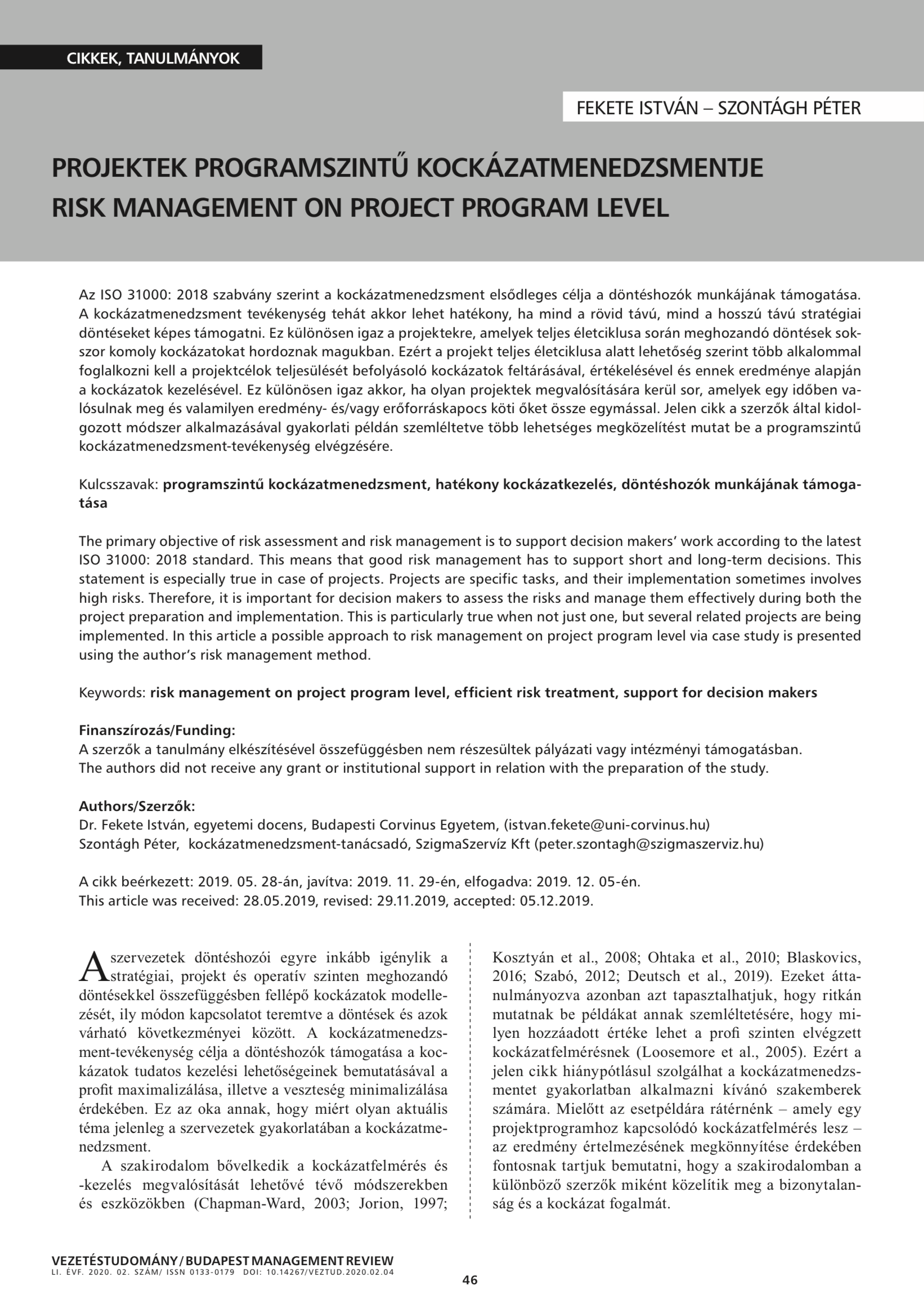Projektek programszintű kockázatmenedzsmentje
DOI:
https://doi.org/10.14267/VEZTUD.2020.02.04Keywords:
risk management on project program level, efficient risk mitigation, support for decision makersAbstract
The primary objective of risk assessment and risk management is to support decision makers’ work according to the latest ISO 31000: 2018 standard. This means that good risk management has to support short and long-term decisions. This statement is especially true in case of projects. Projects are specific tasks, and their implementation sometimes involves high risks. Therefore, it is important for decision makers to assess the risks and manage them effectively during both the project preparation and implementation. This is particularly true when not just one, but several related projects are being implemented. In this article a possible approach to risk management on project program level via case study is presented using the author’s risk management method.
Downloads
References
Aranyossy, M., Blaskovics, B. & Horváth, Á. A. (2015). Információtechnológiai projektek sikere és kudarca. Nemzetközi tapasztalatok és hazai kutatási eredmények. Vezetéstudomány, 46(5), 66-78.
AS/NZS 4360:2004, Risk Management 82004 by Standards Australia and Standards New Zeeland, subsequently replaced by AS/NZS ISO 31000, 2009
Bélyácz, I. (2011). Kockázat, bizonytalanság, valószínűség. Hitelintézeti Szemle, 10(4), pp. 289–313.
Berény, L. (2017). A minőségirányítás fejlődése és jövőbeli lehetőségei. Vezetéstudomány, 48(1), 48-60. https://doi.org/10.14267/VEZTUD.2017.01.05
Blaskovics, B. (2015). A projektvezető vezetési stílusának hatása a projektsikerre – egy hazai vállalat példája alapján. Vezetéstudomány, 46(8), 48-60.
Blaskovics, B. (2016). Differences between managing projects in an SME and in a large company. 4th International Conference on Management and Organization Brdo, 2016. június 10. In Sitar, A.S. et al. (eds.), Corporate Governace Challenges and Development (pp. 159-176). Ljubljana, Slovenia: Slovenian Academy of Management.
Chapman, C. & Ward, S. (2003). Project risk management: Processes, techniques, and insights. Estados Unidos: Wiley.
Deutsch N., Hoffer I., Berényi L., & Nagy Borsi V. (2019). A technológia szerepének stratégiai felértékelődése (pp. 16-19). Budapest, Magyarország: Budapesti Corvinus Egyetem.
Fekete, I. (2000). A kockázatelemzés szerepe a beruházások pénzáramlásának meghatározásában (PhD-értekezés). Budapest, Magyarország: Budapesti Műszaki és Gazdaságtudományi Egyetem. Retrieved from https://unipub.lib.uni-corvinus.hu/638/
Fekete, I. (2015). Integrált kockázatmenedzsment a gyakorlatban. Vezetéstudomány, 46(1), 33-46. Retrieved from https://unipub.lib.uni-corvinus.hu/1856/
Görög, M. (2013). Projektvezetés a szervezetekben. Budapest, Magyarország: Panem Kiadó.
Herz, D. B. (1964). Risk Analysis in Capital Investment. Harward Business Review, 42(January–February), 95–106.
ISO 31000:2018 Risk Management – Principles and Guidelines by the International Organization for Standardization
Jáki E. (2017). Üzleti terv és a pénzügyi terv kapcsolata. In Jáki Erika (ed.), Üzleti terv pénzügyi vonatkozásai (pp. 6-12). Budapest: Befektetések és Vállalati Pénzügyi Tanszék Alapítványa.
Jorion, P. (1997) Value at Risk: The New Brenchmark for Controlling Derivatives Risk. New York, NY: McGraw-Hill Companies Inc.
Knight, F. H. (1921). Risk, Uncertainty and Profit. Boston MA.: Houghton Mifflin Co.
Kosztyán Zs. T., Fejes J. & Kiss J. (2008). Sztochasztikus hálóstruktúrák kezelése projektütemezési feladatokban. Szigma, 39(1-2), 85-103.
Kosztyán, Zs. T. (2015): Költség- és időcsökkentési eljárások alkalmazása a projekttervezésben és a nyomon követésben. Vezetéstudomány, 46(6), 45-57.
Loosemore, M., Raftery, J., & Reilly, C. (2006). Risk Management in Projects (pp. 43–65). London: Taylor & Francis.
Lorenzi, P., Sims, H. P., & Slocum, J. W. (1981). Perceived Environmental Uncertainty: An Individual or Environmental Attribute? Journal of Management, 7(2), 27–41. https://doi.org/10.1177/014920638100700202
Ohtaka, H. & Fukazawa, Y. (2010). Managing Risk Symptom: A Method to Identify Major Risks of Serious Problem Projects in SI Environment Using Cyclic Causal Model. Project Management Journal, 41(1), 51–60. https://doi.org/10.1002/pmj.20144
Olsson, R. (2007). In search of opportunity management: Is the risk management process enough? International Journal of Project Management, 25(8), 745–752. https://doi.org/10.1016/j.ijproman.2007.03.005
Pender, S. (2001). Managing incomplete knowledge: Why risk management is not sufficient. International Journal of Project Management, 19(2), 79–87. https://doi.org/10.1016/s0263-7863(99)00052-6
PMBOK (2018). A Guide to the Project Management Body of Knowledge (6th edition). Newtown Square, Pennsylvania: Project Management Institute.
Tatai T. & Pataki L. (2008). Kockázatelemzés, kockázatmérséklés cselekvési tervek (pp. 28-32). Budapest, Magyarország: Raabe Kiadó.
Szabó L. (2012) Projektmenedzsment (pp. 25-29). Budapest, Magyarország: Pearson Education.
Vasvári, T. (2015). Kockázat, kockázatészlelés, kockázatkezelés – szakirodalmi áttekintés. Pénzügyi Szemle, 60(1), 29-48.
Watchorn, E. (2007). Applying a Structured Approach to Operational Risk Scenario Analysis in Australia (Working paper). Australian Prudential Regulation Authority (APRA).

Downloads
Additional Files
Published
How to Cite
Issue
Section
License
Authors assign copyright to Vezetéstudomány / Budapest Management Review. Authors are responsible for permission to reproduce copyright material from other sources.

